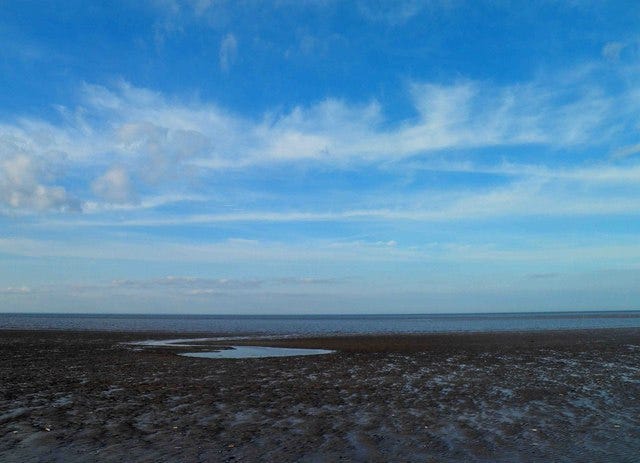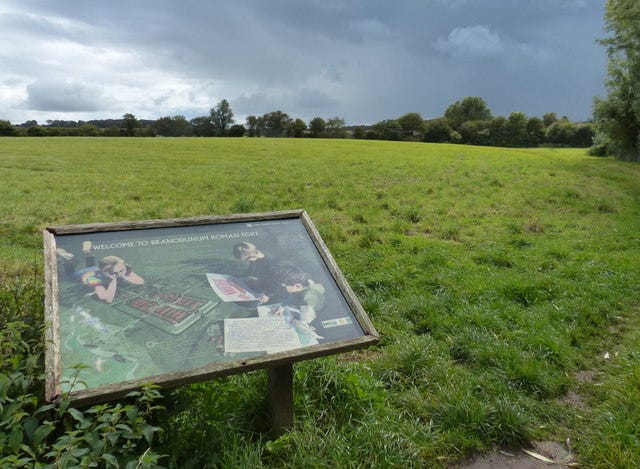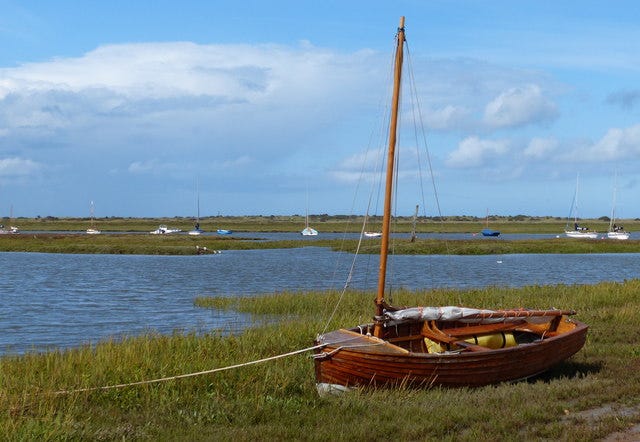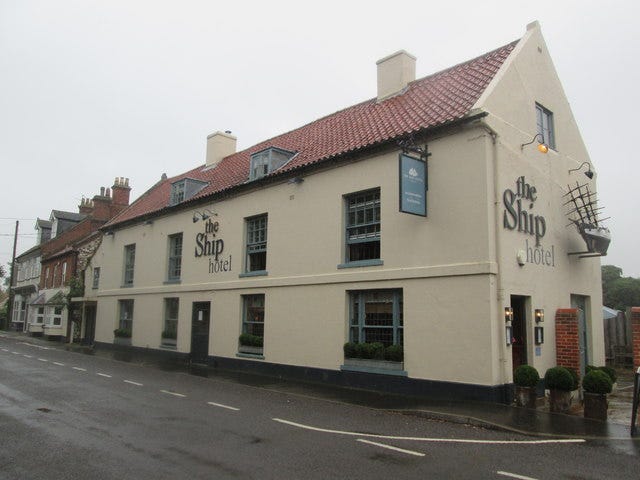Big skies at Brancaster beach (Steve Fareham/geograph)
The twin villages of Brancaster and Brancaster Staithe, two of the many sparkling gems that adorn the ever more popular North Norfolk coast mix an intriguing blend of ancient history with contemporary living.
The seemingly effortless, almost accidental combination of the old and the new has, over recent years, made the villages ever more popular places to visit, whether it be for a week, the traditional long weekend or a day visit.
Big beach. ‘I can see for miles and miles’ as the song goes. (Phillip Halling/geograph)
With that, of course, has come the proliferation of new homes as occasional visitors decide to make their stay a more permanent one, the yearly invasion of ‘outsiders’ now as familiar a feature to the born and bred residents of the villages as the invading Roman hoards (albeit they hailed from what is now modern day Croatia) were to their ancestors nearly two thousand years ago.
The coastal duo have remained a popular destination to both the casual and committed visitor ever since.
But what is their endearing appeal?
Brancaster, sat around seven miles along the coast from the more traditional seaside resort of Hunstanton is well known for being the site of a Roman fort, established slightly to the east of the existing village. The location of that particular settlement has never been a particularly enticing one-all that remains is gentle pasture that is usually inhabited by visiting sheep.
However, its reputation was enough to attract a crew from Channel 4’s popular Time Team programme in 2012*, their consequent examination of the site leading to the deduction that Brancaster, or Branodunum as it was then known, was one of the most important settlements along the coast at the time, with the subsequent archaeology that took place yielding some remarkable finds, discoveries that resulted in one comment from a member from the team that he didn’t have “...enough superlatives to describe this.”
The site of the Roman fort at Brancaster-all quiet-for now! (Mat Fascione/geograph)
Praise indeed when you consider the scope and extent of the programmes success in bringing so much of Britain’s past to life.
But then Brancaster is full of surprises.
Not that its famous beach is one of them.
Sea, sand and skies combine to create a vast canvas one that can be striking in its desolate beauty on an icy winters morning yet beguiling enough to entice Summer visitors in their thousands, the sites simple charms-no amusement arcades, bingo halls and endless racks of tacky ephemera on display here-and the chance to just sit and watch the tide come and go enough for many to justify whiling away a day on the sands.
Popular stretches of sand, and dangerous ones as well. For, when the tide has retreated beyond the horizon at Brancaster, the romantic site of a shipwreck is there for all to see and many to feel compelled to visit, treading over what will ultimately become treacherous waters to get there, even though the shifting sands have all but covered its rusty iron hulk now.
The wreck is of the coaster the SS Vina, commissioned and built at Leith in 1894, a busy ship that would have spent its active years working the crossings between the east coast of England and the near-by Baltic states that laid over the North Sea.
As she neared the end of her active seagoing life in 1940, she was requisitioned by the MOS as a naval blockship, one that would, in the event of enemy invasion, been sunk at the harbour mouth at Great Yarmouth, thus inhibiting the progress of enemy shipping.
As the threat of invasion passed, she was towed to Brancaster to be used as a target for cannon shell trials by the RAF, this time in preparation for another invasion-that of the allied forces into Normandy in 1944.
Unsurprisingly, the RAF crews had no problem in targeting and sinking the Vina and she remains in-situ today, a lasting memory of a time when the whole of Britain’s east coast was under threat of invasion by a somewhat more belligerent force than those it had previously welcomed with open arms.
Laid out alongside the beach and running adjacent to it is the course of the Royal West Norfolk Golf Club, a masterful test of links play on a course that was designed and founded in 1892 and which has, in many ways, changed little since those early days.
It is a traditional links course, rich in golfing history and characterised by vast, sleeper faced bunkers, slick greens and verdant fairways of lush grass. One that is more than worthy of holding a major championship, something which, sadly (or perhaps not?) its remote site and lack of facilities and room for visitors will never happen.
Entrance to the Royal West Norfolk Golf Club. A bastion of niblicks and plus fours (Stephen McKay/geograph)
At the heart of the village is the imposing yet unobtrusive tower of St Mary’s Church, parts of which date to the early thirteenth century. Resourceful early builders made full use of the, even then, ancient Roman fort that laid a mile or so east of the Church, using stones from what remained of the fort as building material for the Church for works that were carried out in both its west and eastern ends.
A keen eye and vivid imagination can mark out these stones to this day, bright and weather beaten with countless ages and stories to share.
If Brancaster is known for its beach and golf church then its close neighbour, Brancaster Staithe is famous for its harbour and the assorted sailing craft that have used it over the centuries.
The Harbour (‘Staithe’ translates as a site that was used for the loading and unloading of cargo boats) still has a resident small fleet of fishing vessels, mainly dealing with sought after delicacies such as mussels, cockles and crabs.
Brancaster mussels are a joy to behold as well as consume and if you are a fan of shellfish you may find them being referred to as such at fish markets and other stalls and places of sale all over the country-I’ve even seen ‘Brancaster Mussels’ for sale in leafy Kingston Upon Thames in Surrey.
Tranquillity at Brancaster Staithe Harbour (Mat Fascione/geograph)
Much of the harbour and land around it is owned and administrated by the National Trust who, once upon a time, had a permanent presence at the site which included a large residential complex that was particularly popular with school parties who flocked there to feast upon the wet and muddy delights of an education amidst the sights and sounds of the North Norfolk coast.
Sadly, partially, perhaps due to, as one old fisherman at nearby Morston Quay told me, the National Trust’s preferred practice of, ‘…spending their time speeding over the landscape on quadbikes’, the site is largely silent now, the joys of an outdoor education that involved mud, getting wet, sunburn and laughter being replaced by the sterility of Zoom and worksheets.
The traditional charms of the two villages are complemented by a wide range of places where you can go to sample some excellent meals as well as some of the local ales on offer, dark and fruity brews that will appeal to any devotee of what an increasing number of people refer to as ‘proper’ beer.
Brancaster’s sole pub, the surviving member of what was once a trio of watering holes, The Ship (currently undergoing its 425th refurbishment in the last ten years) is a contemporary establishment within a building that is reputed to be haunted by the ghost of Lord Nelson’s Nanny.
Whether the afore mentioned multiple renovations to the building have driven the good lady away from her long time residence is open to question, as is the reliability of that particular legend-what is, however, most definitely not legend is the one that tells of her young charge, a small, delicate child known then as plain Horatio Nelson, learning the rudiments of sailing in the harbour and surrounding creeks of Brancaster Staithe.
The Ship at Brancaster, a traditional village pub that became a foodies catnip (Martin Dawes/geograph)
What ended in glorious victory at Trafalgar may well have had its origins within those same muddy channels that are frequented, now, as then, by flocks of his modern day contemporaries, all taking their first steps on the water in a canoe under the watchful eye of gnarled and weather beaten old hands who have been exploring the same creeks for all of their lives.
Perhaps Brancaster is, even now, raising another naval hero?
*The National Trust has since announced that Time Team will be revisiting the site for further investigations in the Autumn, including their using specialist Ground Penetrating Radar (GPR) equipment to ascertain what new archaeological secrets the site may contain.









